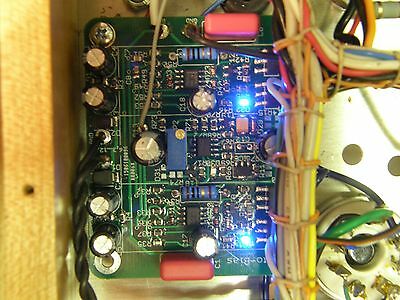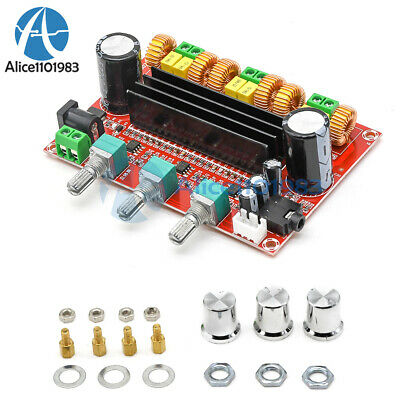-40%
Active Bias Supply for quatro Tubes (Single pcb to Control 4 Power Tubes)
$ 58.08
- Description
- Size Guide
Description
Output Tube Bias Control System.Automatic bias control module for four triode output stages or four tube push-pull (PP) amplifiers
Designed for
class A, AB, or B
amplifiers.
Instructions
and description: audioamp.eu
The module controls bias in
four tubes
.
The module controls automatic bias settings to maintain a strict symmetry of currents through both tube branches in the output stage, and to completely avoid flow of DC current through the output transformer. The DC saturates the output transformer which results in increased distortion of low-frequency sounds.
Bias control is executed by maintaining a constant voltage drop on the output tube cathode resistors, independently on the driving signal.
The module may be supplied by the voltage for tube heating (6.3V or 12V AC) in the amplifier. However, this heating must not have a center tapped winding. An independent 6-12V AC power supply may also be used.
Automatic bias control module for four tubes:
The modules are suitable for all amplifier types (classes A, AB, or B), as well as single-acting amplifiers with A-class tubes connected individually or in parallel.
Their use is strongly recommended in existing amplifiers with fixed bias of output tube control grids, as aging of the tubes causes the need for a constant re-adjustment of their operating points.
The connection secures an absolute symmetry of anode currents through both branches of primary winding of the output transformer. This way, saturation of the the output transformer core with DC current with subsequent signal distortion and dearease in available power is reliably avoided.
Furthermore, tube operating points need no further re-adjustments. The module constantly creates optimum conditions for the output stage, independently of tube aging and consequent changes in their parameters.
Features:
No need to constantly re-adjust tube operating points
Current regulation not influenced by music signal
Regulation of cathode current of the tubes from 1mA to 250mA with a 10Ω cathode resistor. Current match between tubes depends on cathode resistor tolerance. The typical mismatch is << 0.1mA with ± 1% resistors. Perfect current balance for accurate bass sounds
Setting of anode currents through a standard miniature metallic resistor or a multiturn potentiometer
Noise reduction by at least 40db (100 times) resulting with brilliant sound and clearer high-frequency tones
Clear undistorted sound for a great listening experience
Turn on delay of 45 s
Slow ramp up of current over a further 45 s
Fault indication via LEDs (red) on the module board; the LEDs may be also be re-mounted on the amplifier chassis
Fault indication via TTL compatible open collector output – pin 3 (the output may also be used for other protection outputs)
No maintenance or additional setup
Suitable for all types of output transformers (namely toroidal transformers which require automatic control)
Safe operation due to minimized danger of runaway tube current – even when the amplifier is left unattended
Universal use: suitable for all connection types
Fully analogous control: the module has
no digital elements
Electrical data:
Maximum current per tubes with 10Ω cathode resistors: up to 250 mA
Maximum output voltage: up to -150 V (depending on the original voltage of bias source in the amplifier)
Outputs can sink at least 2mA current or much more
Requires a single 6.3 V to 12.6 V AC supply available in the amplifier (i.e. tube filament supply of 60-100mA) for the actual module, and the original negative bias supply of the amplifier (-70 to -150V).
Installation and wiring:
The module is designed for easy installation – one module may control two tubes.
Connect only the existing DC 70-130 V bias voltage and the 6.3-12V AC voltage (taken from the filament supply of the tube.
Note: it must not be a center tapped winding and if one side of the AC winding is grounded, then that side must be connected to pin 4 of the AB-2 module).
The current draw is 60mA at 6.3V and 100mA at 12.6V. The grid and the cathode of each output tube is to be connected at the same time.
Connection requirements:
In order to use the AB-2 module, the amplifier must have the following:
At least one 6.3 V....15 V AC winding that is either one side grounded or floating (not connected to ground at all; may be tested using a multimeter). If one side of the AC winding is grounded, this grounded side must be connected to pin 4 of the AB-2 module. Centertapped windings will not work unless the center tap is disconnected.
The bias supply voltage must be sufficient to bias any tube you may wish to use with this module. For instance, some EL34 amplifiers have insufficient bias voltage under load. All
KT88 and 6550 tubes thus require at least 70V of reliable bias at anode voltage of 430V.
Setting the reference current through the tubes – “R
ref
resistor”:
The AB-2 module is equipped with a resistor used for setting the desired current through the tubes. This resistor is to be replaced by the customer. Prepare a standard “reference” resistor (the small leaded resistor R
ref
in the front part of the module as shown in the diagram above) with 3k3 resistance. This resistor produces a constant current of 38mA with 10Ω between the cathode and the ground. Below is a table of values for R14 resistors for the given current and reference voltage value using the nearest E48 and E24 series resistor. In place of the R
ref
resistor, the supplied multiturn trimmer may be wired. If the resistance value is too high, it can be wired in parallel with the R
ref
resistor to limit the amount of adjustable current.
It is always better to set the cathode current of the end tubes with the trimmer on the module while measuring the voltage on the cathode resistor.
Do you want to pre-set the modules? If so, what will it be value of cathode current?
Need help getting involved?
If so, send a amplifier circuit diagram.
We will draw the circuit diagram of the module connection into the circuit diagram.













